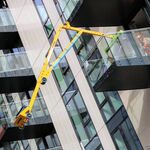Ah my mistake. I guess only a surprise to me then

.
Given that customers all need to get off in Detroit to go through customs, I'm not sure if it's necessarily better to have the same Amtrak train continue to Toronto, versus just getting on a VIA train in Detroit.
Using Amtrak equipment through to Toronto has the advantage that the connection is guaranteed, but a couple disadvantages too:
- Border delays would be able to affect domestic Canadian train services
- Amtrak equipment is limited to 79 mph (127 km/h) in Canada since our signal systems don't meet their PTC requirements. Meanwhile VIA currently operates up to 100 mph (161 km/h) between Windsor and Chatham, and 95 mph (153 km/h) between Aldershot and Toronto.
I skimmed through the
2020-2025 service plan and it only mentions the extension of the Vermonter to Montreal, nothing on the Adirondack or Maple Leaf.
I think the big opportunity with the Adirondack is that once the customs facility opens, overnight services would become viable since customers no longer need to get bothered by customs en route. The line currently takes 10h30, which would be 9h25 without the customs stop or the stop in St Lambert. That's the perfect duration for an overnight train: depart Montréal at 23:00, arrive New York at 08:25.
As for the daytime service, I think the biggest issue is the (lack of) speed. Adding additional round trips wouldn't make the line any more attractive when it takes a 9h30 to cover just 600 km. That's nearly double the time it takes VIA to cover 550 km from Toronto to Montréal.
Part of the issue is that the train serves every single Amtrak station along its route, even where there are other overlapping services. Instead, the service could be repositioned as an express service, with other services picking up the local demand.
March 2020 timetable, marked up in red by me.
View attachment 309799
On top of dropping St Lambert, I think Rouses Points could be dropped as well. Once customs relocates to Montreal, I don't think the tiny town would warrant a station on its own. Or if the station is maintained, it could be served by the overnight service only (which would be conveniently timed for day trips to Montréal).
South of Fort Edward, the route is duplicated by the Ethan Allen Express which runs once daily. If that line is improved to twice daily, I think the stop in Saratoga Springs could be dropped.
In Albany there is a half-hour stop scheduled due to an engine swap: typically the train uses a P42DC diesel locomotive north of Albany and a P32AC Dual Mode locomotive south to New York (due to electric-only operations within Penn Station). But I don't fully understand why they go through the trouble of doing this given that the P32AC-DM is perfectly capable of running the whole way to Montréal. The P42 is more powerful, but its better acceleration wouldn't be enough to offset the half hour spent swapping engines. It must simply be a shortage of dual-mode locomotives. If this is the case, buying some more dual-mode locomotives would be a quick win, eliminating most of the engine swapping which happens in Albany.
South of Albany there is plenty of local service as part of the Empire Corridor. There's no need for the once-daily Adirondack to be serve any local demand. I could run non-stop through the segment, with a single stop at Croton Harmon to connect to Metro-North Commuter services for access to the northern suburbs of New York City.
The other half of the issue is the track quality, primarily north of Schenectady. Part of the problem is on the Canadian side of the border, given that it will still take 2 hours to get 115 km from Montréal to Plattsburgh even after the stops in St Lambert and Rouses Point are dropped.
For the Maple Leaf I think a similar strategy could help, with Amtrak keeping the service at only once per day, but improving the Empire Corridor local services to allow the Maple Leaf to serve fewer stations along the way.




